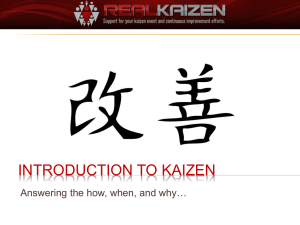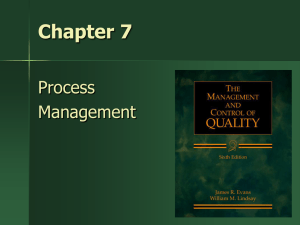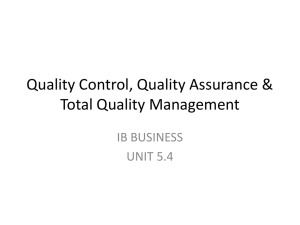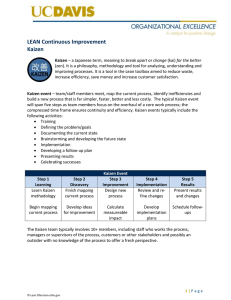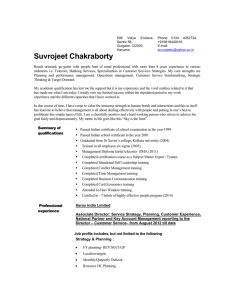Operations Management Operations Management
advertisement
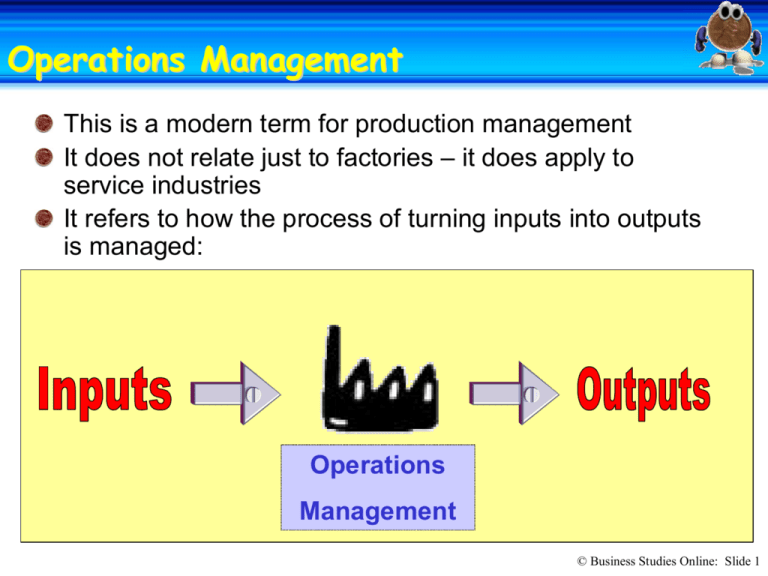
Operations Management Management This is a modern term for production management It does not relate just to factories – it does apply to service industries It refers to how the process of turning inputs into outputs is managed: Operations Management © Business Studies Online: Slide 1 What Does Production Involve? Involve? Clearly production involves combining the four factors of production They are used in order to “ADD­VALUE” to the inputs so that the output can be sold for a profit In order to manage this firms will have to answer the following questions: What should be produced? How should it be produced? Where should it be produced? How big should the firm be? How should the product be distributed? Which method of production would be the most suitable? How will quality be controlled? © Business Studies Online: Slide 2 Methods of Production Production There are 3 main methods of production: Job Production Each item (or job) is completed before the next one is started Eg Tailor­made clothing, Construction jobs (ie Wembley) Batch Production Involves dividing work into different tasks Each task is completed on a number of products before they move onto the next task Eg Bread, Paint Flow Items are continuously moved from one task to another Sometimes called MASS production Eg car manufacturing, Tinned products © Business Studies Online: Slide 3 Value Added Added This is the extra worth of an output as a result of the use of inputs Eg: Cotton Mill turns the cotton into fabric. It then sells this to a dressmaker for £35 Cotton Farmer produces cotton at a cost of £15, and sells for £20 The retailer then sells the dress for £70 The dressmaker turns the fabric into a dress which is sold to a retailer for £50 What is the total value added? © Business Studies Online: Slide 4 Other Methods of Production Production Relatively new methods of production include: Mass Customisation A mix of job and flow production Allows products to be mass produced, and then adapted to individual requirements Eg computers Cell Production A form of flow production Workers are put into teams (or cells) Each team is responsible for meeting set targets Lean Production A combination of factors Largely concerned with quality and efficiency © Business Studies Online: Slide 5 Production & Quality Quality Quality is an important factor since it: Helps create customer loyalty Reduces complaints – and associated costs Lengthens the life­cycle of products Can reduce promotional costs e.g. Can allow a higher price to be charged e.g. Since quality is largely determined during production there is little doubt that the 2 factors are linked This was recognised by the Japanese, and led to the development of lean production © Business Studies Online: Slide 6 Quality Control Techniques Techniques There are 3 methods that can be used Prevention The most effective method This relies upon Quality Assurance Inspection The traditional method This has very high costs Correction & Improvement This uses both of the above Modern businesses approach this using “BENCHMARKING” © Business Studies Online: Slide 7 Quality Assurance Assurance This involves setting standards throughout an organisation It will therefore involve: Product design Quality of raw materials Production quality Delivery systems Customer service including after sales Many businesses will strive to achieve ISO 9000 This is a recognised certificate that a firm has met stringent standards Many government contracts will only be awarded to firms with ISO 9000 © Business Studies Online: Slide 8 Inspecting For Quality Quality This is the most popular method of quality control It involves: Sampling products at the end and during production Employing people to test products Extreme testing – ie damaging products As such it creates a number of problems: It is expensive! It can create resentment between staff It is tedious – but relies upon alertness! It is not foolproof It removes responsibility of quality from other staff It is for these reasons that new methods of quality control have been developed © Business Studies Online: Slide 9 New Approaches to Quality Control Control Over the last few years a number of new approaches have been developed The main ones are: Quality Circles Total Quality Management (TQM) Lean Production Benchmarking Kaizen © Business Studies Online: Slide 10 Quality Circles Circles An idea that originated in Japan This encourages the active participation of workers Workers meet voluntarily in small groups They discuss possible methods of improving quality and productivity “Staff Suggestion boxes” are found more commonly in British businesses © Business Studies Online: Slide 11 Total Quality Management (TQM) (TQM) This involves the development of a new culture within a business Everyone is considered to be responsible for quality Different departments are treated as internal customers In theory this should eradicate the need for a quality control department However, it is dependent upon empowerment of staff © Business Studies Online: Slide 12 Lean Production Production Developed by Toyota to overcome the inefficiencies of mass production It consists of: Reducing the lead time Cell production Workers operate in teams with a “cell” made up of a number of teams Involves treating teams as “internal customers” Just­in­Time Management (JIT) Means that stocks arrive as they are required Quality Circles TQM © Business Studies Online: Slide 13 Benchmarking Benchmarking This involves looking at how the most effective competitors operate Comparing this with the internal operation Identifying areas of improvement There are 6 stages involved in benchmarking: Identifying the focus areas Identify the “benchmark” Undertake the comparison Set new standards within the focus areas Make the changes necessary to meet new standards Evaluate whether standards have been met Therefore “benchmarking” is an on­going process © Business Studies Online: Slide 14 Kaizen Kaizen Based on the Japanese idea that incremental change is better than catastrophic change “Kai” = change “zen” = good Kaizen relies upon staff participation; who meet regularly to suggest improvements to the way work is carried out It is a cheap method of developing new ideas and techniques that can have a massive impact upon the business © Business Studies Online: Slide 15 Kaizen Vs One-Off Improvements Improvements Labour Productivity Continuous Improvement One­off Improvements 0 Time © Business Studies Online: Slide 16 The Importance of Education & Training Training Irrespective of the production method used these 2 factors are vital The more participation required from workers, the more highly trained they will need to be This has resulted in a change in culture within the workplace over the last few years Firms are now much more willing to send workers on training courses © Business Studies Online: Slide 17







